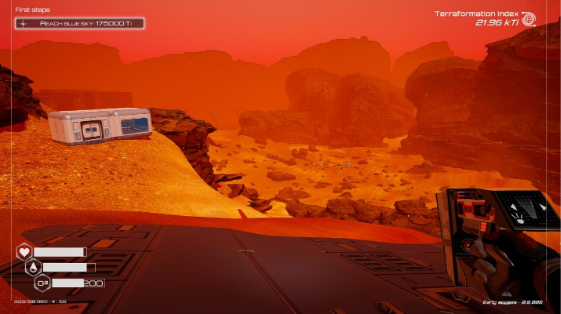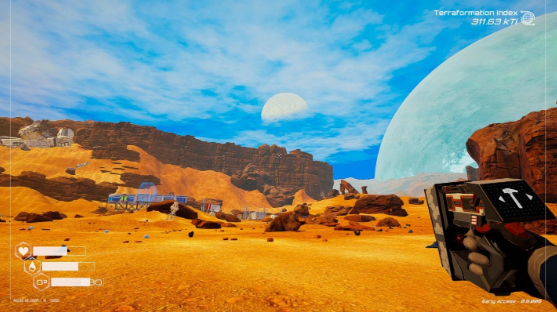Planet Crafter
Planet Crafter by Miju Games (2022). Image by C. A. Ramirez
By C. A. Ramirez
‘Subnautica’ had sweet relations with ‘Astroneer’, and their love-child is ‘Planet Crafter’.
Exploration survival sims are a dime-a-dozen, but Planet Crafter has managed to claw its way to the top of its competitors with a gameplay formula more addictive than the purest skooma. The best way to play Planet Crafter is make sure you do zero research into how the game works and what you need to do. Outside of what actions you are prompted to complete by the game itself, I advise every gamer to figure it out on their own.
True gamers don’t want to be held by the hand and gingerly guided through a mind-numbing tutorial. Rules are for breaking; show me how to play this game and be gone. Planet Crasher will not hold your hand. In fact, it will cut one off.
Like most survival exploration games that emphasize crafting, you are almost always in danger of dying from dehydration, starvation, or exposure to harsh environments. Planet Crafter is no different. As the lone survivor of an exploratory group, it is your job to make your harsh planet livable.
Screenshot by C. A. Ramirez.
Planet Crasher shines in its rate of progression. Each hurdle you overcome feels like you were just awarded first prize in an ass-kicking contest. The first goal is simple enough: make a shelter. Well that only takes a few resources and a zap from your hand-held fabricator because simple structures are erected with ease.
Screenshot by C. A. Ramirez.
Your oxygen tank only allows for a few minutes of exploration before it runs out, and you need to go back to your habitable structure to resupply. You could build life pods every quarter mile, but these require energy to work, and it is up to you to generate that energy.
Solar panels and wind turbines are your first available sources of power. They only require silicon, iron, titanium, and cobalt – abundant resources that are scattered about the entirety of the harsh planet's surface. The name of the game is to hunt down raw resources and turn them into terraforming pieces of equipment that will change the red atmosphere of the planet into a blue one, swirling with oxygen and teeming with organic life.
That is a challenge because for the first few hours of your time on Planet Crasher, traveling more than 100 yards without collapsing from lack of oxygen, food, or water will keep your range of exploration limited…but that only lasts for a short time.
With every change you bring to the planet’s atmosphere, you gain points. The points contribute to a scale called “Ti”, your “Terra reformation Index”. This keeps track of your progress in successfully converting the harsh environment of this planet into a livable one. As it rises, certain thresholds will be met and new pieces of terra reforming technology will be made available to you.
Upgrading your oxygen tank to hold more O2 is the first upgrade that really frees up your ability to traverse the planet. The longer you can explore outside your habitat, the more resources you can gather, and the more equipment you can make. Before you know it, your inventory space will have increased too, and now exploring the red wastelands of this burgeoning planet becomes your own self-made mission.
There are no way-points or points of interest (at first) when you start. Your main goal is to make the red atmosphere blue, and this means exploring the seemingly endless map. Without a compass and no map, you can get lost easily and die from exposure. When the sun sets, you might not be able to see where you went and where you are going, leaving you in a situation where you die meters away from a life pod.
Screenshot by C. A. Ramirez.
The world is precarious, and you are as fragile as a snowflake. There is not a single creature that will hunt you down or kill you; the planet is rude enough to make you lunch without having aliens rip you apart. In Planet Crafter, the world itself is all the danger you need, and it helps emphasize exploration.
Venturing outside your life pod range with limited oxygen canisters can make a journey to find aluminum as exciting as walking down a dimly lit hallway in Resident Evil. You know death is a certainty if you cannot find your way back, but those precious chunks of aluminum are not going to walk themselves back to your steadily expanding base.
Pneumatic drills can be erected to release pressure from beneath the planet's surface. Heaters can be constructed to raise the temperature, and agriculture pods can raise the oxygen levels. These pieces of equipment start out with builds that are easy to construct, costing very few available resources. They’re fine in the beginning as they raise the Ti steadily, but quickly wane as their output is not enough to push the planet into the next tier of progression.
The next version of equipment requires resources that are further from your starting point and also requires you to upgrade your space suit so that you can last longer and move faster in the environment. The pacing is never fraught, as there is no time limit. Your duty is to make the planet fertile for life to take hold on it, however long that takes is up to you. This concept is what turns a seemingly impossible task into one that is fun to undertake. At no point will you feel overwhelmed and just when you want to give up; the game tosses you just what you wanted, that shiny upgrade to your suit.
Planet Crasher is still in “Early Access” (on Steam) but has enough replay value and gameplay polish to hold its own against Subnautica. Resource management games are a dime-a-dozen, but Planet Crasher fills that niche void with a substantive entry that keeps players glued to their seat, desperate to make the inhospitable hospitable.





